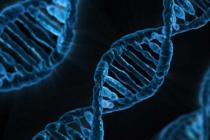Waiting for the birth of a child is the most wonderful time for parents, but also the scariest. Many people worry that the baby may be born with any disabilities, physical or mental disabilities.
Science does not stand still; it is possible to check the baby for developmental abnormalities at early stages of pregnancy. Almost all of these tests can show whether everything is normal with the child.
Why does it happen that the same parents can give birth to completely different children - a healthy child and a child with disabilities? This is determined by genes. The birth of an underdeveloped baby or a child with physical disabilities is affected by gene mutations associated with changes in the structure of DNA. Let's talk about this in more detail. Let's look at how this happens, what gene mutations there are, and their causes.
What are mutations?
Mutations are a physiological and biological change in cell DNA structure. The cause may be radiation (during pregnancy, X-rays cannot be taken to check for injuries and fractures), ultraviolet rays (long exposure to the sun during pregnancy or being in a room with ultraviolet light lamps on). Also, such mutations can be inherited from ancestors. All of them are divided into types.
Gene mutations with changes in the structure of chromosomes or their number
These are mutations in which the structure and number of chromosomes are changed. Chromosomal regions can drop out or double, move to a non-homologous zone, or turn one hundred and eighty degrees from the norm.
The reasons for the appearance of such a mutation are a violation of crossing over.
Gene mutations are associated with changes in the structure of chromosomes or their number and cause serious disorders and diseases in the baby. Such diseases are incurable.
Types of chromosomal mutations
In total, there are two types of main chromosomal mutations: numerical and structural. Aneuploidy is a type of chromosome number, that is, when gene mutations are associated with a change in the number of chromosomes. This is the emergence of an additional or several of the latter, or the loss of any of them.
Gene mutations are associated with changes in structure when chromosomes are broken and later reunited, disrupting the normal configuration.

Types of numerical chromosomes
Based on the number of chromosomes, mutations are divided into aneuploidies, that is, types. Let's look at the main ones and find out the difference.
- trisomy
Trisomy is the occurrence of an extra chromosome in the karyotype. The most common occurrence is the appearance of the twenty-first chromosome. It causes Down syndrome, or, as this disease is also called, trisomy of the twenty-first chromosome.
Patau syndrome is detected on the thirteenth, and on the eighteenth chromosome it is diagnosed. These are all autosomal trisomies. Other trisomies are not viable; they die in the womb and are lost during spontaneous abortions. Those individuals who develop additional sex chromosomes (X, Y) are viable. The clinical manifestation of such mutations is very insignificant.
Gene mutations associated with changes in number occur for certain reasons. Trisomy can most often occur during divergence in anaphase (meiosis 1). The result of this discrepancy is that both chromosomes end up in only one of the two daughter cells, the second remains empty.
Less commonly, chromosome nondisjunction may occur. This phenomenon is called a disorder in the divergence of sister chromatids. Occurs in meiosis 2. This is exactly the case when two completely identical chromosomes settle in one gamete, causing a trisomic zygote. Nondisjunction occurs during the early stages of the cleavage process of an egg that has been fertilized. Thus, a clone of mutant cells arises, which can cover a larger or smaller part of the tissue. Sometimes it manifests itself clinically.
Many people associate the twenty-first chromosome with the age of a pregnant woman, but this factor has not been unambiguously confirmed to this day. The reasons why chromosomes do not separate remain unknown.

- monosomy
Monosomy is the absence of any autosome. If this happens, then in most cases the fetus cannot be carried to term, and premature birth occurs in the early stages. The exception is monosomy due to the twenty-first chromosome. The reason why monosomy occurs can be either chromosome nondisjunction or the loss of a chromosome during its path to the cell in anaphase.
On sex chromosomes, monosomy leads to the formation of a fetus with a XO karyotype. The clinical manifestation of this karyotype is Turner syndrome. In eighty percent of cases out of a hundred, the appearance of monosomy on the X chromosome occurs due to a violation of meiosis of the child’s father. This is due to the non-disjunction of the X and Y chromosomes. Basically, a fetus with a XO karyotype dies in the womb.
Based on sex chromosomes, trisomy is divided into three types: 47 XXY, 47 XXX, 47 XYY. is trisomy 47 XXY. With such a karyotype, the chances of bearing a child are fifty-fifty. The cause of this syndrome may be non-disjunction of X chromosomes or non-disjunction of X and Y spermatogenesis. The second and third karyotypes can occur in only one in a thousand pregnant women; they practically do not appear and in most cases are discovered by specialists completely by accident.
- polyploidy
These are gene mutations associated with changes in the haploid set of chromosomes. These sets can be tripled or quadrupled. Triploidy is most often diagnosed only after a spontaneous abortion has occurred. There were several cases when the mother managed to carry such a baby, but they all died before reaching the age of a month. The mechanisms of gene mutations in the case of triplodia are determined by the complete divergence and non-divergence of all chromosome sets of either female or male germ cells. Double fertilization of one egg can also serve as a mechanism. In this case, degeneration of the placenta occurs. This degeneration is called a hydatidiform mole. As a rule, such changes lead to the development of mental and physiological disorders in the baby and termination of pregnancy.
What gene mutations are associated with changes in chromosome structure
Structural changes in chromosomes are a consequence of chromosome breakage (destruction). As a result, these chromosomes are connected, disrupting their previous appearance. These modifications can be unbalanced or balanced. Balanced ones do not have excess or deficiency of material, and therefore do not manifest themselves. They can only appear in cases where there was a gene at the site of chromosome destruction that is functionally important. A balanced set may produce unbalanced gametes. As a result, fertilization of an egg with such a gamete can cause the appearance of a fetus with an unbalanced chromosome set. With such a set, a number of developmental defects occur in the fetus, and severe types of pathology appear.

Types of structural modifications
Gene mutations occur at the level of gamete formation. It is impossible to prevent this process, just as it is impossible to know in advance whether it can happen. There are several types of structural modifications.
- deletions
This change is due to the loss of part of a chromosome. After such a break, the chromosome becomes shorter, and its severed part is lost during further cell division. Interstitial deletions are when one chromosome is broken in several places at once. Such chromosomes usually create a non-viable fetus. But there are also cases when babies survived, but because of this set of chromosomes they had Wolf-Hirschhorn syndrome, “cry of a cat.”
- duplications
These gene mutations occur at the level of organization of double DNA sections. In general, duplication cannot cause pathologies such as deletions.
- translocations
Translocation occurs due to the transfer of genetic material from one chromosome to another. If a break occurs simultaneously in several chromosomes and they exchange segments, then this becomes the cause of a reciprocal translocation. The karyotype of such a translocation has only forty-six chromosomes. The translocation itself is revealed only through detailed analysis and study of the chromosome.
Change in nucleotide sequence
Gene mutations are associated with changes in the nucleotide sequence when they are expressed in modifications in the structures of certain sections of DNA. According to the consequences, such mutations are divided into two types - without a reading frame shift and with a shift. To know exactly the reasons for changes in DNA sections, you need to consider each type separately.

Mutation without frameshift
These gene mutations are associated with changes and replacements of nucleotide pairs in the DNA structure. With such substitutions, DNA length is not lost, but amino acids may be lost and replaced. There is a possibility that the structure of the protein will be preserved, this will serve Let us consider in detail both development options: with and without replacement of amino acids.
Amino acid substitution mutation
Replacement of an amino acid residue in polypeptides is called missense mutations. There are four chains in the human hemoglobin molecule - two “a” (it is located on the sixteenth chromosome) and two “b” (encoded on the eleventh chromosome). If “b” is a normal chain, and it contains one hundred and forty-six amino acid residues, and the sixth is glutamine, then hemoglobin will be normal. In this case, glutamic acid should be encoded by the GAA triplet. If, due to mutation, GAA is replaced by GTA, then instead of glutamic acid, valine is formed in the hemoglobin molecule. Thus, instead of the normal hemoglobin HbA, another hemoglobin HbS will appear. Thus, replacing one amino acid and one nucleotide will cause a serious serious disease - sickle cell anemia.
This disease is manifested by the fact that red blood cells become shaped like a sickle. In this form, they are not able to properly deliver oxygen. If at the cellular level homozygotes have the formula HbS/HbS, then this leads to the death of the child in early childhood. If the formula is HbA/HbS, then the red blood cells have a weak form of change. Such a weak change has a useful quality - the body's resistance to malaria. In those countries where there is a danger of contracting malaria the same as in Siberia of a cold, this change has a beneficial quality.

Mutation without amino acid substitution
Nucleotide substitutions without amino acid exchange are called seismense mutations. If in the DNA section encoding the “b” chain a replacement of GAA with GAG occurs, then due to the fact that it is in excess, the replacement of glutamic acid cannot occur. The structure of the chain will not be changed, there will be no modifications in the red blood cells.
Frameshift mutations
Such gene mutations are associated with changes in DNA length. The length may become shorter or longer depending on the loss or addition of nucleotide pairs. Thus, the entire structure of the protein will be completely changed.
Intragenic suppression may occur. This phenomenon occurs when there are two mutations that compensate for each other. This is the moment of addition of a nucleotide pair after one has been lost, and vice versa.

Nonsense mutations
This is a special group of mutations. It occurs rarely and involves the appearance of stop codons. This can happen both when nucleotide pairs are lost or added. When stop codons appear, polypeptide synthesis stops completely. This is how null alleles can be formed. None of the proteins will match this.
There is such a thing as intergenic suppression. This is a phenomenon where mutations in some genes suppress mutations in others.
Are changes detected during pregnancy?
Gene mutations associated with changes in the number of chromosomes can in most cases be determined. To find out whether the fetus has developmental defects and pathologies, screening is prescribed in the first weeks of pregnancy (from ten to thirteen weeks). This is a series of simple examinations: blood sampling from a finger and vein, ultrasound. During an ultrasound examination, the fetus is examined in accordance with the parameters of all limbs, nose and head. These parameters, when strongly inconsistent with the norms, indicate that the baby has developmental defects. This diagnosis is confirmed or refuted based on the results of a blood test.
Also, expectant mothers, whose babies may develop mutations at the gene level that are inherited, are also under close medical supervision. That is, these are those women in whose relatives there were cases of the birth of a child with mental or physical disabilities identified as Down syndrome, Patau syndrome and other genetic diseases.
Two years ago, the CRISPR/Cas9 genome modification technology was invented. In 2015, she made a real revolution in genetic engineering. The technology is based on the molecular defense mechanism of microorganisms, thanks to which DNA fragments can be edited and cut out with increased precision. Moreover, this can be done directly in living cells of any organism!
Of course, today manipulation of genes will not surprise anyone, but work with them was previously carried out in specially equipped laboratories at major institutes. But CRISPR/Cas9 technology can become available to everyone. NASA molecular biologist Josiah Zayner intends to develop a kit that would allow experiments with gene modification at home. He will allow him to change the genome of yeast and microorganisms in his kitchen.
How the technology works
The abbreviation CRISPR can be literally translated into Russian as “clustered regularly interspaced short palindromic repeats”; they were first found in the genes of archaea and bacteria. Then it was discovered that microorganisms that managed to survive the attack of the virus inscribe a portion of the enemy’s gene into their own DNA. Thanks to this, the cells formed by the body will be able to recognize such a strain. If the “database” of genes contains information about an enemy, then when they encounter him, microorganisms use a special molecular mechanism. It attaches to the viral DNA in the place that corresponds to the preserved region. Next, Cas group proteins are used to cut it and destroy the virus. Scientists have determined that similar scissors for cutting molecules can be used for any part of the genetic code of mammals, and humans are no exception. With their help, you can replace or edit various genes.
The ODIN online store will begin selling gene code editing kits
According to Mr. Zayner, CRISPR/Cas9 should become publicly available, and even novice researchers and amateurs should be able to conduct experiments with this method. For this purpose, the online store The ODIN was developed. Its goal is to help conduct home experiments with artificially created bacteria. Today, Zayner’s company is raising funds on the Indiegogo crowdfunding platform, offering complete kits and reagents for gene editing as a “reward.”
Available sets
 The products sold are similar to educational kits for conducting chemical experiments by schoolchildren and students. For $75, you can buy a kit here that allows you to add a fluorescent protein to the genome of bacteria, causing them to glow in the dark. To create a genetically modified strain of bacteria that can survive in extreme conditions, you need to buy a kit for $130. But a kit for 160 US dollars will allow you to make changes to the gene code of yeast, adding red pigment to them.
The products sold are similar to educational kits for conducting chemical experiments by schoolchildren and students. For $75, you can buy a kit here that allows you to add a fluorescent protein to the genome of bacteria, causing them to glow in the dark. To create a genetically modified strain of bacteria that can survive in extreme conditions, you need to buy a kit for $130. But a kit for 160 US dollars will allow you to make changes to the gene code of yeast, adding red pigment to them.
The company also offers more expensive sets. For example, for $200 you can get a kit that gives bacteria the ability to fertilize soil and break down plastic. For $500 you can buy a classroom kit - the client can specify the type of kits that will be sent in quantities of 20 for group use. The tools in this set can give bacteria the ability to glow in the dark or change color.
 A $3,000 kit will allow you to create a real home laboratory for conducting experiments in molecular and synthetic biology. It includes: centrifuges, pipettes, reagents, electrophoresis gels, chemicals and much more. The included kit allows you to use the CRISPR system for various studies.
A $3,000 kit will allow you to create a real home laboratory for conducting experiments in molecular and synthetic biology. It includes: centrifuges, pipettes, reagents, electrophoresis gels, chemicals and much more. The included kit allows you to use the CRISPR system for various studies.
The most incredible is the offer for $5,000: the authors of the project promise the opportunity to create a new, unique living organism. With its help, you can isolate the desired characteristic of yeast or bacteria and change it. The owner of such a kit can independently breed genetically modified organisms. The company helps you determine the parameters that will help you achieve your goals! Detailed instructions included with each kit will help you carry out experiments without outside help, although the authors readily promise to provide consultation if necessary.
Future plans
CRISPR technology is capable of making changes to human genes. However, Zayner does not plan to sell kits that would help fight baldness or grow an additional kidney.
To achieve his goal, Zayner launched a crowdfunding campaign on the Indiegogo website. You can view the company. Thanks to growing interest in the CRISPR method, the company's authors managed to obtain the $10,000 needed to create portable kits ahead of schedule. According to Investtok.ru experts, by the end of the campaign, the project’s authors can raise ten times more funds than originally planned, since the audience’s interest in the new technology is enormous.
Changing human DNA that is passed on to future generations has long been considered ethically closed and prohibited in many countries. Scientists report they are using new tools to repair disease-causing genes in human embryos. Although the researchers are using defective embryos and do not intend to implant them into a woman's uterus, the work raises concerns.
Changing the DNA of human eggs, sperm or embryos is known as germinal alteration. Many scientists are calling for a moratorium on the review of clinical embryos, human germline editing, and many believe that this type of scientific activity should be prohibited.
However, editing the DNA of a human embryo may be ethically acceptable to prevent disease in the child, but only in rare cases and with guarantees. These situations may be a limited option for couples where they both have serious genetic conditions and for whom embryo editing is truly the last reasonable option if they want to have a healthy child.
The dangers of deliberately altering genes
Scientists believe that editing a human embryo may be acceptable to prevent a child from inheriting serious genetic diseases, but only if certain safety precautions and ethical criteria are met. For example, a couple may not have “reasonable alternatives,” such as choosing healthy embryos for in vitro fertilization (IVF) or through prenatal testing and aborting a fetus with a disease. Another situation that may qualify is if both parents have the same medical conditions, such as cystic fibrosis.
Scientists warn of the need for strict government oversight to prevent germline editing from being used for other purposes, such as giving a child desirable, distinctive features.
By editing genes in patients' cells that are not inherited, clinical trials are already underway to combat HIV, hemophilia and leukemia. It is believed that existing regulatory systems for gene therapy are sufficient to carry out such work.
Genome editing should not be used to increase potency, increase muscle strength in a healthy person, or lower cholesterol levels.
Human germline gene editing, or human germline modification, refers to the deliberate modification of genes that is passed on to children and future generations.
In other words, creation of genetically modified people. Human germline modification has been considered a taboo topic for many years due to safety and social reasons. It is formally banned in more than 40 countries.
Experiments on creating genetically modified people and the science of eugenics
However, in recent years, experiments have been carried out with human embryos using new methods of genetic engineering. Genes and human embryos associated with beta blood disease - thalassemia - were used for research. The experiments were largely unsuccessful. But gene editing tools are being refined in laboratories around the world and are expected to make it easier, cheaper and more precise to edit or delete genes than ever before. Modern, yet theoretical methods of genome editing will allow scientists to insert, delete and correct DNA with positive results. This opens up the prospect of treating certain diseases, such as sickle cell disease, cystic fibrosis and certain types of cancer.
Selection applied to humans – eugenics
Gene editing of human embryos or the direction of eugenics leads to the creation of genetically modified very different people. This raises serious safety concerns due to social and ethical issues. These range from the prospect of irreversible harm to the health of future children and generations to the opening of the door to new forms of social inequality, discrimination and conflict and a new era of eugenics.
The science of eugenics in human selection came into being in the middle of the last century as a Nazi science.
Scientists are not allowed to make changes to human DNA that is passed on to subsequent generations. Such an innovative move by the science of eugenics should only be considered after further research, after which changes can be carried out under strict restrictions. Such work should be prohibited to prevent serious illness and disability.
Variation caused by changes in genes is also called mutations.
It is a long-standing taboo to make changes to the genes of human sperm, eggs or embryos because such changes will be inherited by future generations. This is taboo in part because of fears that mistakes could inadvertently create new man-made diseases that could then become a permanent part of the human gene pool.
Another concern is that this species could be used for genetic modification for non-medical reasons. For example, scientists could theoretically try to create designer babies in which parents try to select their children's personality traits to make them smarter, taller, better athletes, or other supposedly necessary attributes.
Nothing like this is currently possible. But even the prospect raises the fear of scientists to significantly change the course of evolution and the creation of people who are considered genetically improved, to come up with dystopias of the future described in films and books.
Any attempt to create babies from sperm, eggs or embryos that have their own DNA and attempt to edit can only be done under very carefully controlled conditions and only to prevent a devastating disease.
It may be difficult to further draw the line between using gene editing to prevent or treat disease and using it to enhance a person's capabilities.
For example, if scientists can find that gene changes improve thinking abilities to fight off Alzheimer's dementia, then this could be considered preventive medicine. If you simply radically improve the memory of a healthy person, then this is no longer a medical direction.
When is it legal to change DNA?
The ability to edit genes could be used to treat many diseases and perhaps even prevent many devastating disorders from occurring in the first place by editing out genetic mutations in sperm, eggs and embryos. Some potential changes could prevent a wide range of diseases, including breast cancer, Tay-Sachs disease, sickle cell disease, cystic fibrosis and Huntington's disease.
Gene editing clinical trials should be permitted if:
- there is no “reasonable alternative” to prevent “serious illness”
- it has been convincingly proven that genes, when edited, eliminate the cause of the disease
- changes are aimed only at transforming genes that are associated with normal health conditions
- sufficient preliminary research has been conducted on the risks and potential health benefits
- ongoing, rigorous oversight to examine the impact of the procedure on the health and safety of participants, as well as long-term comprehensive plans
- There is maximum transparency in accordance with patient confidentiality and reassessment of health, social benefits and risks
- There are strong surveillance mechanisms in place to prevent the spread of a serious disease or condition.
Proponents of human germline editing argue that it could potentially reduce, or even eliminate, the occurrence of many serious genetic diseases and reduce human suffering around the world. Opponents say altering human embryos is dangerous and unnatural, and does not take into account the consent of future generations.
Discussion on modification of the human embryo
 Let's start with the objection that changing the embryo is unnatural or playing against God.
Let's start with the objection that changing the embryo is unnatural or playing against God.
This argument is based on the premise that what is natural is inherently good.
But diseases are natural and millions of people get sick and die prematurely - everything is completely natural. If we only protected natural beings and natural phenomena, we would not be able to use antibiotics to kill bacteria or otherwise practice medicine or fight drought, famine, pestilence. The healthcare system is being run in every developed country and can rightly be described as part of a comprehensive attempt to thwart the course of nature. Which is naturally neither good nor bad. Natural substances or natural treatments are better, if they are possible, of course.
Leads to an important moment in the history of medicine and genome editing and represents promising scientific endeavors for the benefit of all humanity.
Intervention in the human genome is allowed only for preventive, diagnostic or therapeutic purposes and without modifications for descendants.
Rapid advances in the field of so-called “designer babies” genetics increase the need for bioethics to engage in broader public debate and debate about the power of science. Science is able to genetically modify human embryos in the laboratory to control inherited traits such as appearance and intelligence.
As of now, many countries have signed an international convention prohibiting this type of gene editing and DNA modification.
Hereditary information is transmitted from one generation of microorganisms to another by a large number of genes contained in the nucleotide of each cell. The information contained in the gene is read and used to synthesize a specific enzyme protein. The presence of this enzyme protein creates the chemical basis for the manifestation of a certain trait in a microorganism. As a result, all hereditary characteristics of microorganisms are the end products of biochemical processes, which is equally applicable to physiological characteristics and morphological characteristics.
One gene can control the inheritance of one trait or determine several or many traits affecting different parts of the cell of a microorganism. In other cases, several genes may jointly control the expression of a single trait. In a bacterial chromosome, all genes are arranged in a linear sequence. Genes for certain traits lie in corresponding places on the chromosome, called loci. Bacteria are usually haploid: they have only one set of genes.
The complete set of genes possessed by a microorganism's cell represents the genotype of that microorganism. The manifestation of inherited morphological characteristics and physiological processes in individuals is called phenotype (from the Greek faino - to manifest, to show). Microorganisms similar in genotype can differ significantly in phenotype, that is, in the way in which hereditary characteristics manifest themselves. Phenotypic differences between microorganisms of the same genotype are called modifications (phenotypic adaptations). Thus, the interaction of genetic inclinations with the external environment can cause the emergence of different phenotypes, even if the genotypes are identical. However, the potential magnitude of such phenotypic differences is controlled by genotype.
Modifications, as a rule, exist as long as the specific environmental factor that caused them is in effect; they are not transmitted to descendants and are not inherited by them. Thus, treatment of bacteria with flagella with phenol prevents the development of flagella in these organisms. However, the progeny of phenol-treated flagellaless bacteria grown on phenol-free media develop normal flagella.
It has been established that almost all morphological and physiological characteristics of microorganisms are directly or indirectly controlled by genetic information contained in DNA.
The information that DNA carries is not something absolutely stable and unchanging. If information transmitted from one generation to another were not capable of change, then the range of reactions of closely related organisms to environmental factors would also be constant and any sudden change in them, which turned out to be harmful for microorganisms with a frozen genotype, could lead to the extinction of the species . Consequently, information transmitted from generation to generation is not absolutely stable, which turns out to be useful for the survival of the species.
Changes in the genotype, called mutations (from the Latin mutare - to change), occur spontaneously, that is, by chance. Such mutations cause dramatic changes in single genes responsible for the information contained in the cell. As a rule, rare DNA replication errors are not accompanied by massive changes in information involving a large number of different characters. However, organisms have developed other mechanisms that contribute to the emergence of dramatically altered heredity in the offspring. These mechanisms involve the association and usually immediate reshuffling (recombination) of genes belonging to closely related but genotypically different organisms. During genetic recombination, fragments of the chromosome of the donor microorganism are inserted into the chromosome of one microbial cell serving as a recipient.
In microorganisms, the ability to recombine genes can be represented in the form of a diagram.
Currently, three types of character transfer from donor to recipient are known in microorganisms: transformation, conjugation and transduction. microorganism aerobic iron salt
Mutation: An allele that occurs in a population with a frequency equal to or less than 1%. The reason for the variability of organisms is not only combinational variability, but also mutations. These are changes in the genome that consist either in the appearance of new alleles (they are called gene mutations), or in the rearrangement of chromosomes, for example, in the transfer of a piece of one chromosome to another (then they are called chromosomal mutations), or in changes in the genome (genomic mutations). An example of a genomic mutation is a change in the number of chromosomes in a cell. Individual mutations occur rarely. For example, gene mutations occur in about one gene in hundreds of thousands or even a million. However, since there can be quite a lot of genes, mutations make a significant contribution to variability. Mutations were discussed above both in connection with DNA and in connection with the work of Morgan. In Morgan, the sign of the mutation was some kind of morphological difference in Drosophila, which is inherited. It showed that the genetic material of the mutant differs from the genome of wild-type flies. Where it comes from was not asked at first. Mutations are randomly occurring persistent changes in the genotype that affect entire chromosomes, their parts or individual genes. Mutations can be large and clearly visible, for example, lack of pigment (albinism), lack of plumage in chickens (Fig. 11), short legs, etc. However, most often mutational changes are small, barely noticeable deviations from the norm. The term "mutation" was introduced into genetics by one of the scientists who rediscovered Mendel's laws - G. de Vries in 1901 (from the Latin mutatio - change, change). This term meant newly arising hereditary changes, without the participation of crossings. As already mentioned, mutations are divided into gene mutations, chromosomal mutations and genomic mutations (Fig. 118). It should be noted that with chromosomal and genomic mutations, new genes do not appear in the genome; in fact, this is some shuffling of old genes. At first glance, it would be more logical to attribute such variability to combinational variability. However, when determining sex, the appearance of an extra X chromosome in the genome can cause radical changes in the phenotype. Therefore, there has historically been a tradition to classify such genome changes as mutations. In addition to classifying mutations according to the method of occurrence, they are also classified according to other characteristics. 1). Direct mutations are mutations that cause a deviation from the wild type. Back mutations are a return to the wild type. 2). If mutations occur in germ cells, they are called generative mutations (from lat. generatio - birth), and if in other cells of the body - somatic mutations (from the Greek soma - body). Somatic mutations can be transmitted to offspring during vegetative propagation. 3). Based on the results, mutations are divided into beneficial, neutral and harmful (including sterile, semi-lethal and lethal). Semi-lethal mutations are harmful mutations that greatly reduce viability, but are not fatal, while lethal mutations lead to the death of the organism at one or another stage of development. Sterile mutations are those that do not affect the viability of the organism, but sharply (often to zero) reduce its fertility. Neutral mutations are mutations that do not change the viability of the organism. Typically, DNA is copied exactly during the replication process and remains unchanged between two successive replications. But occasionally mistakes occur and the DNA sequence changes - these mistakes are called mutations. A mutation is a stable heritable change in DNA, regardless of its functional significance. This definition implies a change in the primary nucleotide sequence, while other changes, such as methylation, are usually attributed to epigenetic events. Mutations in somatic cells may cause aging processes, cancer and other, less significant changes in the body. Mutations in the germ cells of parents are inherited by children. The idea that mutations are stable in general remains correct, but the discovery of dynamic mutations due to an increase in the number of trinucleotide repeats shows that some mutations change during somatic or germ cell division. Some mutations are lethal and cannot be passed on to the next generation, while others are not so dangerous and persist in the offspring. From an evolutionary perspective, mutations provide enough genetic diversity to allow species to adapt to environmental conditions through natural selection. Each genetic locus is characterized by a certain level of variability, that is, the presence of different alleles, or variants of DNA sequences, in different individuals. In relation to a gene, alleles are divided into two groups - normal or wild-type alleles, in which the function of the gene is not impaired, and mutant alleles, which lead to disruption of the gene. In any population and for any gene, wild-type alleles are predominant. A mutation is understood as all changes in the DNA sequence, regardless of their location and impact on the viability of the individual. Thus, the concept of mutation is broader than the concept of a mutant allele. In the scientific literature, variants of gene sequences that are frequently found in populations and do not lead to noticeable impairments of function are usually considered as neutral mutations or polymorphisms, while the concepts “mutation” and “mutant allele” are often used interchangeably. Mutations can involve DNA sections of different lengths. This may be a single nucleotide, in which case we will talk about a point mutation, or an extended section of the molecule. In addition, given the nature of the changes, we can talk about nucleotide substitutions, deletions and insertions (insertions), and inversions. The process of mutations is called mutagenesis. Depending on the factors causing mutations, they are divided into spontaneous and induced. Spontaneous mutations occur spontaneously throughout the life of an organism under normal environmental conditions. Spontaneous mutations in eukaryotic cells occur at a frequency of 10-9-10-12 per nucleotide per cell generation. Induced mutations are those that arise as a result of mutagenic effects under experimental conditions or under adverse environmental influences. Among the most important mutagenic factors, first of all, it is necessary to note chemical mutagens - organic and inorganic substances that cause mutations, as well as ionizing radiation. There are no significant differences between spontaneous and induced mutations. Most spontaneous mutations arise as a result of mutagenic effects that are not recorded by the experimenter. It must be emphasized that the usefulness or harmfulness of mutations depends on living conditions: in some environmental conditions a given mutation is harmful, in others it is beneficial. For example, a mutation that causes albinism will be beneficial for the inhabitants of the Arctic, providing white protective coloration, but harmful, unmasking for animals living in other conditions. Variation provides material for the action of natural selection and underlies the evolutionary process. Mutations provide material for breeders to work on. The production and selection of beneficial (for humans) mutations underlie the creation of new varieties of plants, animals and microorganisms. The classification of mutations is based on the molecular processes of their occurrence.
History of the formation of microbiology as a science
Microbiology (from the Greek micros. small, bios. life, logos. teaching) is a science that studies the structure, vital activity and ecology of microorganisms of the smallest life forms of plant or animal origin, invisible to the naked eye.
Microbiology studies all representatives of the microcosm (bacteria, fungi, protozoa, viruses). At its core, microbiology is a fundamental biological science. To study microorganisms, she uses methods from other sciences, primarily physics, biology, bioorganic chemistry, molecular biology, genetics, cytology, and immunology. Like any science, microbiology is divided into general and specific. General microbiology studies the patterns of structure and vital activity of microorganisms at all levels. molecular, cellular, population; genetics and their relationship with the environment. The subject of the study of private microbiology is individual representatives of the microworld, depending on their manifestation and influence on the environment, living nature, including humans. Special sections of microbiology include: medical, veterinary, agricultural, technical (biotechnology section), marine, space microbiology. Medical microbiology studies microorganisms pathogenic to humans: bacteria, viruses, fungi, protozoa. Depending on the nature of the pathogenic microorganisms being studied, medical microbiology is divided into bacteriology, virology, mycology, and protozoology. Each of these disciplines considers the following issues: - morphology and physiology, i.e. carries out microscopic and other types of research, studies metabolism, nutrition, respiration, conditions of growth and reproduction, genetic characteristics of pathogenic microorganisms; - the role of microorganisms in the etiology and pathogenesis of infectious diseases; - main clinical manifestations and prevalence of caused diseases; - specific diagnosis, prevention and treatment of infectious diseases; - ecology of pathogenic microorganisms. Medical microbiology also includes sanitary, clinical and pharmaceutical microbiology. Sanitary microbiology studies the microflora of the environment, the relationship of microflora with the body, the influence of microflora and its metabolic products on human health, and develops measures to prevent the adverse effects of microorganisms on humans. Focus on Clinical Microbiology. The role of opportunistic microorganisms in the occurrence of human diseases, diagnosis and prevention of these diseases. Pharmaceutical microbiology studies infectious diseases of medicinal plants, spoilage of medicinal plants and raw materials under the influence of microorganisms, contamination of medicinal products during the preparation process, as well as finished dosage forms, methods of asepsis and antiseptics, disinfection in the production of medicinal products, technology for obtaining microbiological and immunological diagnostic, preventive and medicinal drugs. Veterinary microbiology studies the same issues as medical microbiology, but in relation to microorganisms that cause animal diseases. Microflora of the soil, flora, its influence on fertility, soil composition, infectious plant diseases, etc. are the focus of agricultural microbiology. Marine and space microbiology studies, respectively, the microflora of seas and reservoirs and outer space and other planets. Technical microbiology, which is part of biotechnology, develops technology for obtaining various products from microorganisms for the national economy and medicine (antibiotics, vaccines, enzymes, proteins, vitamins). The basis of modern biotechnology is genetic engineering. Numerous discoveries in the field of microbiology, the study of the relationships between macro- and microorganisms in the second half of the 19th century. contributed to the beginning of the rapid development of immunology. At first, immunology was considered as the science of the body's immunity to infectious diseases. Currently, it has become a general medical and general biological science. It has been proven that the immune system serves to protect the body not only from microbial agents, but also from any substances genetically foreign to the body in order to maintain the constancy of the internal environment of the body, i.e. homeostasis. Immunology is the basis for the development of laboratory methods for diagnosis, prevention and treatment of infectious and many non-infectious diseases, as well as the development of immunobiological drugs (vaccines, immunoglobulins, immunomodulators, allergens, diagnostic drugs). Immunobiotechnology is involved in the development and production of immunobiological drugs. an independent branch of immunology. Modern medical microbiology and immunology have achieved great success and play a huge role in the diagnosis, prevention and treatment of infectious and many non-infectious diseases associated with a disorder of the immune system (oncological, autoimmune diseases, organ and tissue transplantation, etc.).
Iron transformations
In a normal temperate climate, a healthy person requires 10-15 mg of iron per day in food. This amount is quite enough to cover its losses from the body. Our body contains from 2 to 5 g of iron, depending on the level of hemoglobin, weight, gender and age. There is especially a lot of it in blood hemoglobin - two-thirds of the total amount contained in the body; the rest is stored in the internal organs, mainly in the liver.
Iron from food is absorbed in the intestines and transported to the blood vessels, where it is captured by a special transport protein. This protein was first discovered back in 1920 in blood serum. But the analysis methods that existed at that time did not allow us to accurately determine its structure. Only in 1945, Swedish scientists K-Holmberg and K.-B. Laurel studied this iron-containing protein in detail, established its nature and gave it the name “transferrin”.
Interestingly, a similar protein was also isolated from milk in 1939 and was named “lactoferrin”. The molecular weights of these proteins are approximately the same and amount to about 80 thousand. They are able to bind 2 iron atoms, giving them a characteristic reddish color. Lactoferrin was then discovered in tears, bile and other body fluids. Strictly speaking, transport proteins perform a similar function to hemoglobin, only they transport not oxygen, but iron, and trivalent iron. It is transported mainly to the bone marrow, a small part enters the liver and spleen, where it is stored as a reserve fund; a small amount goes to the formation of myoglobin and some enzymes of tissue respiration. The main organs in which iron metabolism occurs are the bone marrow, liver and small intestine, where there are special receptors that serve to receive transferrin.
In the bone marrow, the formation of hemoglobin and red blood cells occurs, the lifespan of which is about 4 months. After this time, hemoglobin is destroyed, breaking down into heme and globin. Further transformations of these substances proceed in different ways. Globin is hydrolyzed to amino acids, and heme in the liver is converted into bile pigments - green biliverdin, which is reduced to bilirubin, which is yellow-orange or brown. Only a small part of these pigments enters the blood again, but mostly they are excreted from the body. With liver diseases, such as jaundice, an excess amount of bilirubin enters the blood, which gives the characteristic yellow color to the skin and whites of the eyes.
We said above that some of the iron in the body is stored in reserve. Under normal conditions, this reserve iron is part of the red-brown water-soluble protein ferritin, which is widespread in the plant and animal world. It is found in vertebrates, invertebrates, flowers and even mushrooms. This suggests its universal role and ancient evolutionary origin. Ferritin was first isolated by F. Laufberger in 1937 from the spleen of a horse. Somewhat later, its role as a compound that accumulates iron in the body was established. Ferritin molecules are iron aggregates in the form of complex compounds surrounded by apoferritic protein with a molecular weight of 480 thousand. Such a complex can contain up to 4.5 thousand iron atoms. If transferrin is similar in value to hemoglobin, then ferritin in this respect is similar to myoglobin.
So, the main amount of iron circulates in our body, some accumulates in ferritin, and a very small amount settles in the form of insoluble granules of the protein hemosiderin. Iron can be stored in ferritin and hemosiderin for a long time - until the body urgently needs it, for example, during blood loss. Then the reserve iron is used for the synthesis of hemoglobin. How it is extracted from storage proteins has not yet been precisely established. In all likelihood, a number of substances that are in one way or another connected with iron in our body have not been established.
Microorganisms and the environment. Physical factors (salt concentration)
Previous chapters have described various microorganisms, grouped according to their physiological and biochemical properties. Habitats were also mentioned. The information obtained now allows us to consider the relationship of microorganisms with their environment. We will first focus on the basic concepts and ideas of ecology. This science studies the behavior of organisms in their natural habitats, their relationships with each other and with the environment. The first traces of life date back to more than 3 billion years ago; these were microorganisms that dominated the Earth's biosphere until a period of about 0.5 billion years ago. Thus, prokaryotes not only stand at the origins of earthly life, from them not only did all the diversity of eukaryotic forms develop, but they always existed after that. Higher forms of life throughout their evolution were never alone; they were constantly either crowded out or supported by ubiquitous single-celled organisms. Among modern higher forms of life there are those that have established themselves not only in the fight against their own kind, but also in relationships with microorganisms. In the process of evolution, many organisms have developed tolerant, partnership-based relationships - mutualistic symbiosis. Microorganisms already existed when the surface of our planet took its present form; they were already present at a time when continents shifted, sediments several thousand meters thick were created, the earth’s crust sank and folded many times, deposits of ores, coal, oil and natural gas deposits arose. Microorganisms actively participated in many of these processes. For at least 80% of the entire period of organic evolution, the Earth was inhabited exclusively by microorganisms. If fossil remains of microbes are rarely found, then data from comparative physiology and biochemistry provide sufficient support for classifying prokaryotes according to the type of metabolism. However, when reading the section on the evolution of organisms, it should be taken into account that there are still many gaps and speculations in this area. PHYSICAL FACTORS
Dead Sea mineral water has high thermal conductivity and heat capacity. Thus, the first impact factor is temperature. The main site of application is the skin. Irritation of the nerve receptors of the skin causes diffuse inhibition in the cerebral cortex, i.e. relieving overstrain as a result of psychological stress, stress, etc. When exposed to intense heat during a bath, heat loss through sweating increases, which promotes the body's detoxification processes. In addition, the thermal effect on the muscles helps them relax. In a Dead Sea salt bath, a column of water 40-50 cm high exerts a pressure of 1/5 of an atmosphere, which stimulates the function of respiration and blood circulation. The vessels of the abdominal organs react to changes in the temperature of the skin: an increase in external temperature, accompanied by dilation of the skin vessels, leads to a narrowing of the vessels of the abdominal organs and vice versa. The exception is the kidneys: vasodilation of the skin leads to vasodilation of the kidneys. To obtain an adequate vascular response, the temperature of all parts of the body must be equalized before taking a bath. For example, cold feet should be warmed in a basin or under running hot water. In this case, the vascular reaction will go in the right direction and the effect of the bath will be positive. Based on the above, it is recommended to take baths with Dead Sea salts at a water temperature of 37-39 degrees, lasting from 10 to 15 minutes.
Conversion of phosphorus
The phosphorus cycle is much simpler than carbon and nitrogen. It mainly consists of the mineralization of organic phosphorus and the transfer of phosphate salts from less soluble to more soluble salts (phosphorus mobilization). In the body of animals and plants, phosphorus is part of protein substances (nucleoproteins) and some lipoids (lecithins). This phosphorus, after the death of animals and plants during decomposition by putrefactive and other microbes, is mineralized and turns into phosphoric acid, which is quickly bound by bases and turns into sparingly soluble salts of calcium, magnesium, iron, unsuitable for plant nutrition. Further, the conversion of these sparingly soluble salts into soluble salts occurs as a result of biochemical processes accompanied by acid formation. These processes produce acid-forming bacteria, namely nitrifying bacteria, sulfur bacteria, thionic bacteria, ammonifying bacteria, which form large amounts of carbon dioxide, especially you. mycoides.
The sparingly soluble tricalcium salt is converted into a readily soluble dicalcium phosphorus salt:
Ca3(PO4)2+2CO2+2H2O=2CaHPO4+Ca(HCO3)2
Ca3(PO4)2+4HNO3=Ca(H2PO4)2+2Ca(NO3)2,
which is absorbed by plants.
Under anaerobic conditions, soil bacteria can reduce phosphate salts up to hydrogen phosphide in the presence of organic matter. In this case, valuable phosphoric acid salts are lost. The best remedy against this harmful process is good soil aeration.
Aerobic cellulose decomposition
Decomposition of cellulose under aerobic conditions. In well-aerated soils, cellulose is decomposed and used by aerobic microorganisms (fungi, myxobacteria and other eubacteria), and in anaerobic conditions, mainly clostridia. Under aerobic conditions, fungi play a significant role in the decomposition of cellulose. They are more effective than bacteria in this regard, especially in acidic soils and in the decomposition of lignin-encrusted cellulose (wood). Representatives of two genera, Fusarium and Chaetomium, play a major role in this process. Cellulose is also broken down by Aspergillus fumigatus, A. nidulans, Botrytis cinerea, Rhizoctonia solani, Trichoderma viride, Chaetomium globosum and Myrothecium verrucaria. The last three species serve as test organisms for detecting the decomposition of cellulose, as well as for testing products used to impregnate various materials in order to protect them from the action of microorganisms that decompose cellulose. Fungi produce cellulases, which can be isolated from mycelium and from the nutrient medium. Cytophaga and Sporocytophaga are aerobic bacteria that decompose cellulose. They are most easily isolated by the usual method of enrichment culture in liquid media. These two genera, closely related to myxobacteria, include many species. Little is known about the use of cellulose by myxobacteria and their primary effects on it. They were unable to detect either extracellular cellulase or any cellulose breakdown products. The cells of these bacteria are closely adjacent to the cellulose fibers, located parallel to the fiber axis. Apparently, they hydrolyze cellulose only in close contact with the fiber, and the hydrolysis products are immediately absorbed. On cellulose agar, Cytophaga colonies are never surrounded by a transparent zone in which the products of enzymatic breakdown of cellulose would be located. In addition to Cytophaga species, mixo bacteria of the genera Polyangium, Sporangium and Archangium, forming fruiting bodies, can grow on cellulose. Many of those aerobic bacteria that could be called “omnivorous” can also use cellulose as a substrate for growth. Some of them use cellulose, apparently only in cases where there are no other carbon sources; the synthesis and secretion of cellulases in such bacteria are regulated by catabolite repression. Some forms similar to Pseudomonas were previously grouped as Cellvibrio. They are now described as Pseudomonas fluorescens var. cellulosa. Of the coryneform bacteria, mention should be made of Cellulomonas; this bacterium was even supposed to be used to obtain protein from cellulose. Among actinomycetes, only a few cellulose-decomposing species have been described: Micromonospora chalcea, Streptomyces cellulosae, Streptosporangium. Decomposition of cellulose under anaerobic conditions. Under anaerobic conditions, cellulose is most often broken down by mesophilic and thermophilic clostridia. The thermophilic species Clostridium thermocellum grows on simple synthetic media, using cellulose or cellobiose as a substrate, and ammonium salts as a source of nitrogen; This bacterium does not utilize glucose and many other sugars. The products of cellulose fermentation are ethanol, acetic, formic and lactic acids, molecular hydrogen and CO2. Outside cells, cellulose is probably broken down only to cellobiose. Fermentation of cellulose by the mesophilic species Clostridium cellobioparum leads to similar products. The long rod Bacillus dissolvens behaves similarly to the Cytophaga species mentioned above: the cells of this bacterium closely adhere to cellulose fibers and do not release cellulase into the environment.
Respiration is a process that ensures the metabolism of living organisms from the environment with oxygen (O2) and releases into the environment in a gaseous state some of the body's metabolic products (CO2, H2O, etc.). Breathing is the main form of dissimilation in humans, animals, plants and many microorganisms. During respiration, chemical energy-rich substances belonging to the body are oxidized to energy-poor end products (carbon dioxide and water), using molecular oxygen.
The term “anaerobes” was introduced by Louis Pasteur, who discovered butyric acid fermentation bacteria in 1861. Anaerobic respiration is a set of biochemical reactions occurring in the cells of living organisms when using not oxygen, but other substances (for example, nitrates) as the final acceptor of protons and refers to the processes of energy metabolism (catabolism, dissimilation), which are characterized by the oxidation of carbohydrates, lipids and amino acids to low molecular weight compounds.
Lactic acid fermentation is the anaerobic conversion of sugar by lactic acid bacteria to form lactic acid.
Alcoholic fermentation is a chemical fermentation reaction carried out by yeast, as a result of which one molecule of glucose is converted into 2 molecules of ethanol and 2 molecules of carbon dioxide.
Butyric acid fermentation is the process of converting sugar by butyric acid bacteria under anaerobic conditions to produce butyric acid, carbon dioxide and hydrogen.
Nitrification is a microbiological process of oxidation of ammonia to nitrous acid or itself further to nitric acid, which is associated either with energy production (chemosynthesis, autotrophic nitrification) or with protection from reactive oxygen species formed during the decomposition of hydrogen peroxide (heterotrophic nitrification).
Denitrification (dissimilatory nitrate reduction) is the sum of microbiological processes of the reduction of nitrates to nitrites and then to gaseous oxides and molecular nitrogen. As a result, their nitrogen returns to the atmosphere and becomes unavailable to most organisms. It is carried out only by prokaryotes (both bacteria and archaea) under anaerobic conditions and is associated with their production of energy.
Nitrogen fixation - fixation of molecular atmospheric nitrogen, diazotrophy. The process of reducing a nitrogen molecule and incorporating it into their biomass by prokaryotic microorganisms. The most important source of nitrogen in the biological cycle. In terrestrial ecosystems, nitrogen fixers are localized mainly in the soil.
Streptococci. Streptococci are round, small, cocci arranged in chains of varying lengths. Often these chains consist of paired cocci - diplo-streptococci. Streptococci are stained with Gram stain. They are found in sputum with bronchitis, abscess, and gangrene of the lungs. Streptococci found among and inside leukocytes are considered pathogenic.
Staphylococci. Round cocci of various sizes, located in groups, as well as single ones, are stained with conventional paints and Gram stains. Staphylococci are often found inside white blood cells. Streptococci are often observed simultaneously in sputum.
Tetracocci (micrococcus tetragenus). They look like oval or round cocci of various sizes, arranged in groups of four and surrounded by a common capsule. Gram stained. In sputum they are observed in abscess and gangrene of the lungs, bronchitis, and also as a secondary infection in tuberculosis, more often in the presence of cavities.
SARCINA (from Latin sarcina - ligament, node), spherical bacteria (cocci), forming cubic packet-like clusters. motionless; not pathogenic.
BACILLES (from the Latin bacillum - rod), rod-shaped bacteria. In the narrow sense, bacilli are rod-shaped bacteria that form intracellular spores (resting forms, resistant to high temperatures, radiation and other adverse effects). Some bacilli cause diseases in animals and humans, such as anthrax and tetanus.
Clostridia (lat. Clostridium) is a genus of gram-positive, obligate anaerobic bacteria capable of producing endospores. Individual cells are elongated rods; the name of the genus comes from the Greek klptfed (spindle). Many species that were classified as clostridia based on this morphological character were later reclassified. Endospores can be located centrally, eccentrically and terminally. The diameter of endospores often exceeds the diameter of the cell.
Spirilla (New Latin spirilla, diminutive of Latin spira, Greek speira - bend, twist, turn) are bacteria that have the shape of spirally twisted or arched rods. S.'s dimensions vary widely among different species: width from 0.6--0.8 to 2--3 microns, length from 1--3.2 to 30--50 microns. S. do not form spores, are gram-positive, and are motile thanks to a bundle of flagella located at the end of the cell. There are species of S. that grow poorly on laboratory nutrient media; individual species were not isolated at all in pure culture. S. - saprophytes; They live in fresh and salt water bodies, and are also found in rotting stagnant water, slurry and the intestinal contents of animals.
Spirochetes (lat. Spirochaetales) - an order of bacteria with long (3-500 microns) and thin (0.1-1.5 microns) spirally (Greek ureisb “curl”) twisted (one or more turns of a spiral) cells .
Actinomycetes (obsolete radiant fungi) are bacteria that have the ability to form branching mycelium at some stages of development (some researchers, emphasizing the bacterial nature of actinomycetes, call their analogue of fungal mycelium thin filaments) with a diameter of 0.4-1.5 microns, which manifests itself in them under optimal conditions for existence. They have a gram-positive type of cell wall and a high (60-75%) content of GC pairs in DNA.
Mycobacteriaceae are a family of actinomycetes. The only genus is Mycobacterium. Some representatives of the genus Mycobacterium (eg M. tuberculosis, M. leprae) are pathogenic for mammals (see tuberculosis, mycobacteriosis, leprosy).
Ensilage is one of the ways to preserve and store succulent feed. Good-quality silage has a pleasant aromatic smell of pickled vegetables and fruits, light green, yellowish-green and brownish-green color with an acidity in the range of 3.9-4.2. It is an excellent component of diets during the winter period and is readily eaten by animals.
haylage - dehydration of green plants in order to create a water deficit that prevents the development of unwanted bacteria when storing the mass without access to air. Unlike silage, fermentation processes during the preparation of haylage are inhibited, since the grass is dried in the field to a moisture content of 45-55%, as a result of which the so-called physiological dryness of the mass is achieved.
Gram-negative bacteria (designated Gram (-)) are bacteria that, unlike Gram-positive bacteria, become discolored when washed using the Gram stain method. After bleaching, they are usually colored pink with an additional dye (muchsin).
THERMOGENESIS is the production of heat by the body to maintain a constant body temperature and ensure the functioning of all its systems, from the functioning of intracellular processes to ensuring blood circulation, digestion of food, the ability to move, etc.
Pasteurization is the process of one-time heating, most often of liquid products or substances, to 60 °C for 60 minutes or at a temperature of 70-80 °C for 30 minutes. The technology was discovered in the mid-19th century by French microbiologist Louis Pasteur. It is used to disinfect food products, as well as to extend their shelf life.
Sterilization (from Latin sterilis - sterile) - complete release of various substances, objects, food products from living microorganisms.
Gram-positive bacteria (designated Gram (+)) are bacteria that, unlike gram-negative bacteria, retain color and do not become discolored when washed using the Gram staining method for microorganisms.
Adhesion (from Latin adhaesio - sticking) in physics is the adhesion of the surfaces of dissimilar solids and/or liquids. Adhesion is caused by intermolecular interaction (van der Waals, polar, sometimes by the formation of chemical bonds or mutual diffusion) in the surface layer and is characterized by the specific work required to separate the surfaces. In some cases, adhesion may be stronger than cohesion, i.e., adhesion within a homogeneous material; in such cases, when a breaking force is applied, a cohesive rupture occurs, i.e., a rupture in the volume of the less durable of the contacting materials.
Commensalism (Latin con mensa - literally “at the table”, “at the same table”) is a way of coexistence of two different types of living organisms, in which one population benefits from the relationship, while the other receives neither benefit nor harm (for example , silverfish and humans).
PHAGIA (from the Greek phagos - devourer), a component of complex words, corresponding in Meaning to the words eater, absorber.
Satellism is an increase in the growth of one type of microorganism under the influence of another microorganism. When several types of microbes grow together, their physiological functions can be activated, resulting in faster exposure to the substrate. For example, colonies of yeast or sarcin, releasing metabolites into the nutrient medium, stimulate the growth of some other microorganisms around their colonies.
Phytohormones are low molecular weight organic substances produced by plants and having regulatory functions. Low concentrations of phytohormones are effective (up to 10–11 M), while phytohormones cause various physiological and morphological changes in plant parts sensitive to their action.
1. Forms of microorganisms
2. Structure of a bacterial cell

3. Organs of movement of bacteria

4. Microscope structure

5. Colony shapes

6. Colony profiles.

7. Edge of the Colonies

8. Nitrogen conversion cycle

9. Phosphorus conversion cycle

10. Sulfur conversion cycle


Combinative variability
It is hereditary in nature and is caused by the recombination of genes in the genotype. It is not associated with changes in genes, but with their combination! Combinations of genes contribute to increased survival in changing environmental conditions.
Random combination of gametes during fertilization
Exchange of regions of homologous chromosomes during crossing over in prophase of meiosis 1
Independent segregation of different pairs of chromosomes in anaphase of meiosis 1, leading to the formation of genetically diverse gametes
Mutational variability
Mutations are sudden, abrupt, persistent changes in the genotype that occur under the influence of external or internal environmental factors and are inherited. At the molecular level, this is a change in DNA that persists during NK replication. Mutagenesis is the process of mutation formation. Mutagenic factors cause mutations, which by their nature can be
- physical mutagens: radiation a, b, gamma, UV, temperature, humidity,
- chemical mutagens: organic and inorganic, narcotic substances, products of industrial processing of natural compounds (coal, oil), synthetic substances not previously found in nature (pesticides, insecticides, herbicides), food preservatives, medicines. They have high penetrating ability, cause gene mutations and act during DNA replication.
Classification of mutations according to conditions of occurrence
Spontaneous ones occur for no apparent reason, or the reasons are unknown.
Induced ones arise as a result of exposure.
Classification of mutations by localization in the cell
Nuclear - mutations in the cell nucleus
Cytoplasmic - mutations in mitochondria and plastids.
Classification of mutations according to the possibility of inheritance
Generative ones arise in germ cells and are inherited during sexual reproduction
Somatic occur in somatic cells and are inherited during vegetative propagation
Classification of mutations according to the degree of influence on life ability and fertility
Sterile affect fertility
Lethal lead to death
Semi-lethal reduce vitality
Neutral does not affect vitality
Positive ones increase vitality
Classification according to the level of damage to genetic material:
Genetic – gene change
Chromosomal - changes in the structure of a chromosome,
Genomic – changes in the genome
Gene mutations
Points lead to changes in the nucleotide structure of DNA in a gene. Changes in gene structure when bases are replaced are of 2 types: missense mutations with amino acid substitution, nonsense with the formation of terminal codons UAA, UAG, UGA.
- reading frame shift occurs when multiple nucleotides are inserted or deleted. As a result, the breakdown of mRNA into codons changes, which means that the amino acid sequence in the synthesized protein molecule changes, or the synthesis ends prematurely.
- transition - replacement of a purine base with another purine, and a pyrimidine with another pyrimidine: A<-->G and C<-->T.
- transversion - replacement of purine with pyrimidine and vice versa.
Chromosomal mutations
Aberrations are changes in the structure of chromosomes due to a violation of their integrity: breaks that are accompanied by gene rearrangements lead to intra/interchromosomal mutations.
- deletion - loss of a chromosome section: AEF. Deletion of the short arm of chromosome 5 in humans is called cat cry syndrome.
- duplication - doubling of a chromosome region: ABCDCD, with the appearance of additional hereditary material identical to what is already in the genome.
Deletion and duplication always manifest themselves phenotypically, since the set of genes changes and monosomy of some chromosomes is observed.
- inversion – rotation of individual chromosome sections by 180*. ABCDEF -----> AEDCBF
- translocation – transfer of a separate section of a chromosome to another place on the same or another chromosome: ABCKLM. Wherein the number of genes does not change !!! Transfer of the 21st chromosome arm to 13, 14, 15 leads to the development of Down syndrome.
Inversions and translocations may not manifest themselves phenotypically if there is no change in the genetic material and the overall balance of genes in the genome is maintained. But the conjugation of homologous chromosomes becomes more difficult, which can cause disruption of the genetic material between daughter cells
Genomic mutations
Associated with a change in the number of chromosomes, leading to the addition or loss of one, several or a complete set of chromosomes.
Genome- a set of genes of a haploid set of chromosomes. As a rule, it is found in germ cells.
- polyploidy - a multiple haploid increase in the number of chromosomes in cells. Often used in plant breeding, it usually leads to increased yields. Often found among angiosperms, less often among gymnosperms. Among animals, polyploidy is known in hermaphrodites: worms, crustaceans, insects, fish, salamanders. For mammals, polyploidy is lethal.
- haploidy - a multiple haploid reduction in the number of chromosomes. As a result, the cell contains a single set of n chromosomes. An organism with a haploid set of non-homologous chromosomes in somatic cells is a haploid. Natural haploidy occurs in the life cycle of spore-forming fungi, bacteria, unicellular algae, and in bee drones. The viability of haploids decreases as all recessive genes contained in the singular appear. For mammals, haploidy is lethal.
- aneuploidy - multiple change in the number of chromosomes.
Trisomy is an increase in the karyotype by one chromosome (2n+1).
Polysomy is an increase in the karyotype by more than one chromosome.
Monosomy is a decrease in the karyotype by one chromosome (2n-1).
Nulisomy - the absence of a pair of chromosomes, is lethal.
Human chromosomal diseases
Groups of diseases associated with changes in the number of chromosomes (genomic mutations) or their structure (chromosomal aberrations). They arise as a result of a violation of the chromosome set in the zygote due to nondisjunction of chromosomes during reduction division, and various chromosomal aberrations.
triploidy - violation of chromosome set 3n. Newborn children die in the first hours or days after birth.
trisomy X chromosome - XXX. The phenotype is normal female, characterized by underdevelopment of the gonads, a slight degree of mental retardation.
Klinefelter syndrome - ХХУ, ХХХУ, ХХХХУ, ХУУ, ХУУУ, ХХУУ, ХХХУУ. Male phenotype - underdeveloped testes. In appearance, there are narrow shoulders, a wide pelvis, genicomastia, and fat deposition typical for women. Polysomy on the Y chromosome results in high growth and antisocial behavior.
Shereshevsky-Turner syndrome : violation of the X0 chromosome set, the only viable monosomy on the X chromosome in humans. Female phenotype, disproportionate body structure, skin folds on the neck, growth retardation, underdeveloped internal genital organs, infertility, premature aging.
Down syndrome : trisomy on chromosome 21. Short stature, small round head, flat back of the head, low-set ears, slanted eyes, short nose with a flat bridge, half-open mouth, thick tongue, low muscle tone, short fingers, crooked little fingers, sluggish and clumsy people. Severe mental retardation, poorly developed speech, reduced immunity and life expectancy.
Patau syndrome : trisomy on chromosome 13. Deep idiots. Underdeveloped central nervous system, moderate microcephaly, corneal opacity, low forehead, sunken nose bridge, narrow eye sockets, bilateral cleft lip and palate, anomalies in the development of the central nervous system and internal organs. They die before the age of one year; only a few survive to 3 years.
Edwards syndrome : trisomy on chromosome 18. Anomalies of the skull and face: narrow forehead with retraction of the frontal bones in the fontanel area, wide protruding occiput, small lower jaw and mouth opening, narrow and short palpebral fissures, low ears, short sternum, wide chest, abnormal development of the foot, pathologies of the heart structure and blood vessels, digestive system, cerebellum. Most die before the age of one year.
Fill out an application to prepare for the Unified State Exam in biology or chemistry
Brief feedback form














